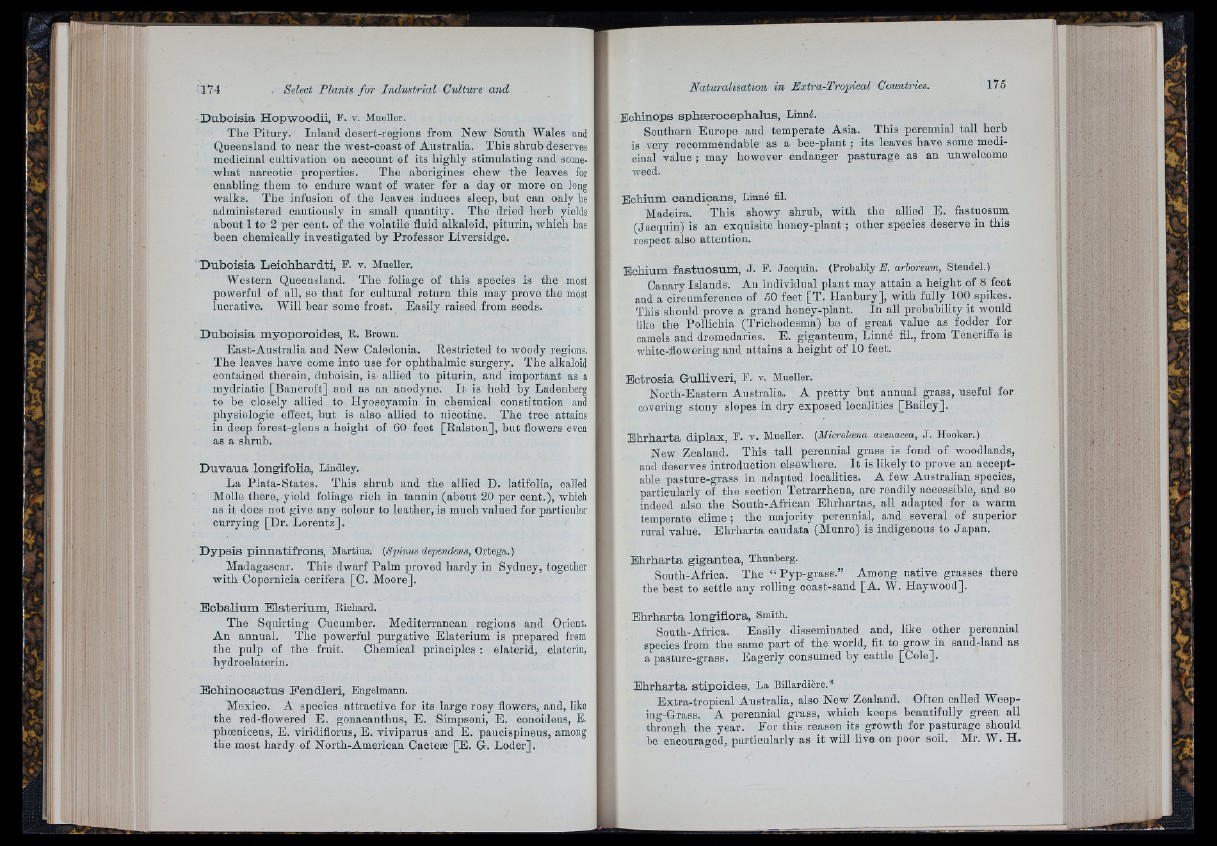
D u b o is ia H o pw o o d ii, P. V. Mueller.
The Pitury. Inland desert-regions from New South Wales and
Queensland to near the west-coast of Australia. This shrub deserves
medicinal cultivation on account of its highly stimulating and somewhat
narcotic properties. The aborigines chew the leaves for
enabling them to endure want of water for a day or more on long
walks. The infusion of the leaves induces sleep, but can only be
administered cautiously in small quantity. The dried herb yields
abont 1 to 2 per cent, of the volatile fluid alkaloid, piturin, which has
been chemically investigated by Professor Liversidge.
D u b o is ia L e ic h h a rd ti, P. v. Mueller.
Western Queensland. The foliage of this species is the most
powerful of all, so that for cultural return this may prove the most
lucrative. Will bear some frost. Easily raised from seeds.
D u b o is ia m y o p o ro id e s , R. Brown.
East-Australia and New Caledonia. Restricted to woody regions.
The leaves have come into use for ophthalmic surgery. The alkaloid
contained therein, duboisin, is allied to piturin, and important as a
mydriatic [Bancroft] and as an anodyne. I t is held by Ladenberg
to be closely allied to Hyoscyamiu in chemical constitution and
physiologic effect, but is also allied to nicotine. The tree attains
iu deep forest-gleus a height of 60 feet [Ralston], but flowers even
as a shrub.
D u v a u a lo n g ifo lia , Lindley.
La Plata-States. This shrub and the allied D. latifolia, called
Molle there, yield foliage rich in tannin (about 20 per cent.), which
as it does not give any colour to leather, is much valued for particular
currying [Dr. Lorentz].
D y p s is p in n a tif ro n s , Martius. (Spinus dependens, Ortega.)
Madagascar. This dwarf Palm proved hardy in Sydney, together
with Copernicia cerifera [C. Moore].
B c b a lium B la te rium , Richard.
The Squirting Cucumber. Mediterranean regions and Orient.
An annual. The powerful purgative Elaterium is prepared from
the pulp of the fruit. Chemical principles : elaterid, elaterin,
hydroelaterin.
E c h in o c a c tu s P e n d le r i, Engelmann.
Mexico. A species attractive for its large rosy flowers, and, like
the red-flowered E . gonacanthus, E . Simpsoni, E. conoideus, E.
phoeniceus, E. viridiflorns, E. viviparus and E. paucispineus, among
the most hardy of North-American Cactese [E. G-. Loder].
Bchinops sp h a a ro c e p h a lu s, Linné.
Southern Europe and temperate Asia. This perennial tall herb
is very reeommendable as a bee-plant ; its leaves have some medicinal
value ; may however endanger pasturage as an unwelcome
weed.
Bohium c a n d ic a n s , Linné fil.
Madeira. This showy shrub, with the allied E. fastuosum
(Jacquin) is an exquisite honey-plant ; other species deserve in this
respect also attention.
Bchium f a s tu o s um , J. P. Jacquin. (Probably A arhoreum, Steudel.)
Canary Islands. An individual plant may attain a height of 8 feet
and a circumference of 50 feet [T . Hanbury], with fully 100 spikes.
This should prove a grand honey-plant. In all probability it would
like the Polliohia (Trichodesma) be of great value as fodder for
camels and dromedaries. E . giganteum, Linné fil., from Teneriffe is
white-flowering and attains a height of 10 feet.
Bo tro sia GuUiveri, P. v. Mueller.
North-Eastern Australia. A pretty but annual grass, useful for
covering stony slopes in dry exposed localities [Bailey].
B h rb a rta d ip lax , P- V. Mueller. (Microlcena avenacea, J. Hooker.)
New Zealand. This tall perennial grass is fond of woodlands,
and deserves introduction elsewhere. I t is likely to prove an acceptable
pasture-grass in adapted localities. A few Australian species,
particularly of the section Tetrarrhena, are readily accessible, and so
indeed also the South-African Ehrhartas, all adapted for a warm
temperate clime ; the majority perennial, and several of superior
rural value. Eh rharta caudata (Munro) is indigenous to Japan.
B h rb a rta g ig a n te a , Thunberg.
South-Africa. The “ Pyp-grass.” Among native grasses there
the best to settle any rolling coast-sand [A. W. Haywood].
E h rh a rta lo n g iflo ra , Smith.
South-Africa. Easily disseminated and, like other perennial
species from the same part of the world, fit to grow iu sand-land as
a pasture-grass. Eagerly consumed by cattle [Cole].
B h rb a rta s tip o id e s , La Biliardière.*
Extra-tropical Australia, also New Zealand. Often called Weep-
ing-Grass. A perennial grass, which keeps heautifully green all
through the year. For this reason its growth for pasturage should
be encouraged, particularly as it will live on poor soil. Mr. W. H .